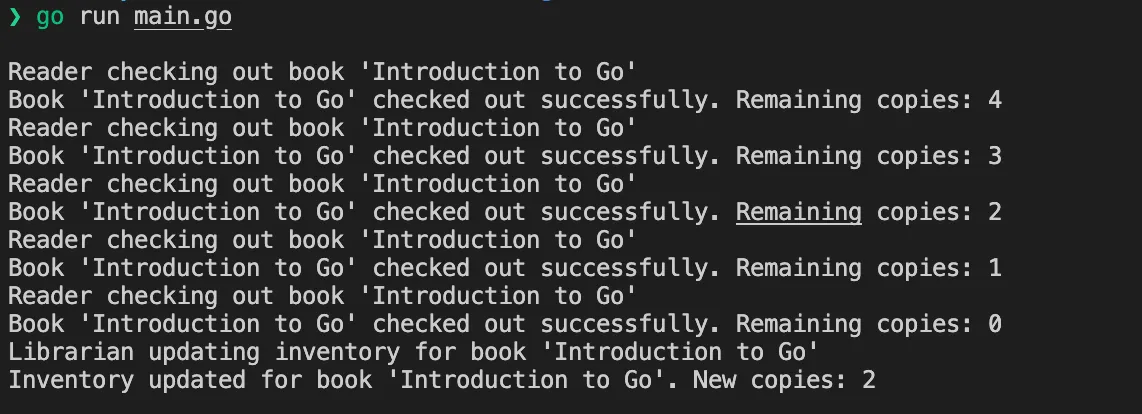Synchronization in Go: Mutex Explained
The sync package in Go helps you manage multiple parts of your program that might run at the same time (concurrently) and need to coordinate with each other to avoid conflicts or errors. It provides tools like locks (mutexes), conditions, and wait groups to make sure that different parts of your program don’t interfere with each other when they’re accessing shared resources or performing tasks simultaneously. This helps ensure that your program runs smoothly and safely even in a multi-threaded or concurrent environment.

sync.Mutex
A sync.Mutex in Go is like a lock that one part of your program can hold while it’s doing something important, to prevent other parts from interfering. It ensures that only one thing can happen at a time.
Real-life Example: Bank Account Transactions
package main
import (
"fmt"
"sync"
"time"
)
var balance int
var mutex sync.Mutex
func deposit(amount int) {
mutex.Lock()
defer mutex.Unlock()
balance += amount
fmt.Printf("Deposited $%d. New balance: $%d\n", amount, balance)
}
func withdraw(amount int) {
mutex.Lock()
defer mutex.Unlock()
if balance >= amount {
balance -= amount
fmt.Printf("Withdrawn $%d. New balance: $%d\n", amount, balance)
} else {
fmt.Println("Insufficient funds.")
}
}
func main() {
balance = 1000
go deposit(200)
go withdraw(300)
go deposit(500)
time.Sleep(time.Second) // Allow goroutines to finish before exiting
}Output:

In this example, multiple goroutines are simulating deposits and withdrawals from a bank account. The sync.Mutex ensures that only one operation (either deposit or withdrawal) can modify the balance at a time, preventing conflicts.
sync.RWMutex
A sync.RWMutex in Go is like a special lock that allows multiple parts of your program to read data at the same time but ensures that only one part can write (modify) data at a time. It’s useful when you have data that is read frequently but modified less often.
Real-life Example: Book Inventory
package main
import (
"fmt"
"sync"
"time"
)
type Library struct {
books map[string]int
inventoryMutex sync.RWMutex
}
func (l *Library) checkoutBook(title string) {
l.inventoryMutex.RLock()
defer l.inventoryMutex.RUnlock()
// Simulate reading (checking out) a book
fmt.Printf("Reader checking out book '%s'\n", title)
remainingCopies := l.books[title]
if remainingCopies > 0 {
l.books[title]--
fmt.Printf("Book '%s' checked out successfully. Remaining copies: %d\n", title, remainingCopies-1)
} else {
fmt.Printf("Book '%s' is out of stock.\n", title)
}
}
func (l *Library) updateInventory(title string, copies int) {
l.inventoryMutex.Lock()
defer l.inventoryMutex.Unlock()
// Simulate updating (restocking) the book inventory
fmt.Printf("Librarian updating inventory for book '%s'\n", title)
l.books[title] += copies
fmt.Printf("Inventory updated for book '%s'. New copies: %d\n", title, l.books[title])
}
func main() {
library := &Library{
books: map[string]int{
"Introduction to Go": 5,
"Concurrency in Go": 3,
"Data Structures in Go": 7,
},
}
// Readers (concurrent checkouts)
for i := 1; i <= 5; i++ {
go func(readerID int) {
time.Sleep(time.Millisecond * time.Duration(readerID)) // Simulate staggered checkouts
library.checkoutBook("Introduction to Go")
}(i)
}
time.Sleep(time.Second) // Allow some time for readers to start before updating inventory
// Writer (updating inventory)
library.updateInventory("Introduction to Go", 2)
time.Sleep(time.Second) // Allow some time for readers and writer to finish before exiting
}Output:

In this example, the sync.RWMutex is used to coordinate access to a shared resource, such as a book inventory in a library. It allows multiple goroutines to read the inventory concurrently using RLock, ensuring efficient parallel reads. For exclusive updates, Lock is employed, guaranteeing that only one goroutine can modify the inventory at a time, preventing conflicts. This ensures a balance between efficient concurrent access for reading and exclusive access for writing, optimizing the program’s performance and integrity in a multi-goroutine setting.
sync.WaitGroup
sync.WaitGroup in Go is like a counter that helps the main program wait for a group of tasks (goroutines) to finish before moving on. It ensures that the main program doesn’t exit prematurely, giving time for all the concurrent tasks to complete.
Real-life Example: Parallel Image Processing
package main
import (
"fmt"
"sync"
"time"
)
var wg sync.WaitGroup
func processImage(imageID int) {
defer wg.Done()
time.Sleep(time.Second) // Simulate image processing
fmt.Printf("Image %d processed\n", imageID)
}
func main() {
for i := 1; i <= 5; i++ {
wg.Add(1)
go processImage(i)
}
wg.Wait() // Wait for all image processing tasks to finish
fmt.Println("All images processed.")
}Output:

In this example, sync.WaitGroup is used to wait for all image processing tasks to complete before proceeding. It ensures that the main program doesn’t exit before all goroutines finish processing.
sync.Once
sync.Once in Go is like a guard that ensures a specific action is performed only once, no matter how many times it’s called. It’s useful for one-time initializations or tasks that should happen exactly once in your program.
Real-life Example: Server Configurations
package main
import (
"fmt"
"sync"
)
// Configuration represents the server configuration.
type Configuration struct {
Port int
IsDebug bool
// ... other configuration parameters
}
var (
serverConfig Configuration
once sync.Once
)
// initializeServerConfig simulates the one-time initialization of server configuration.
func initializeServerConfig() {
fmt.Println("Initializing server configuration...")
serverConfig = Configuration{
Port: 8080,
IsDebug: false,
// ... initialize other configuration parameters
}
}
// getServerConfig returns the server configuration, initializing it if not done already.
func getServerConfig() Configuration {
once.Do(initializeServerConfig)
return serverConfig
}
func main() {
// In different parts of your program, you might need the server configuration.
// The configuration will be initialized only once.
config1 := getServerConfig()
config2 := getServerConfig()
fmt.Println("Config1:", config1)
fmt.Println("Config2:", config2)
}Output:

In this example, initializes a server configuration using sync.Once, ensuring the configuration is set up only once. The getServerConfig function retrieves the configuration, initializing it if needed.
Conclusion
In conclusion, the sync package in Go provides essential synchronization primitives for managing concurrent execution and shared resources. Through constructs like Mutex for mutual exclusion, RWMutex for readers-writer locking, WaitGroup for coordinating goroutines, and Once for one-time initialization, the package empowers developers to write safe and efficient concurrent programs. These synchronization tools enable controlled access to shared data, prevent race conditions, and ensure tasks are performed only when necessary. By understanding and judiciously using these primitives, Go developers can achieve effective coordination in concurrent scenarios, promoting thread safety and efficient parallelism in their applications.